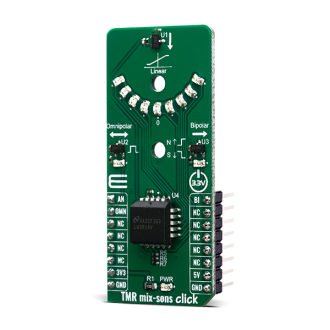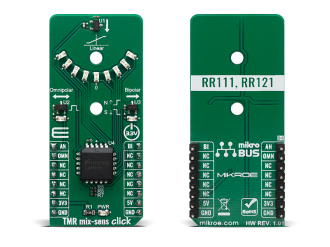
We strongly encourage users to use Package manager for sharing their code on Libstock website, because it boosts your efficiency and leaves the end user with no room for error. [more info]

Rating:
Author: MIKROE
Last Updated: 2020-05-11
Package Version: 1.0.0.0
mikroSDK Library: 1.0.0.0
Category: Magnetic
Downloaded: 3447 times
Not followed.
License: MIT license
The TMR mix-sens Click is an add-on board equipped with the TMR digital push-pull and analog magnetic sensors, as well as intensity of magnetic field indicator.
Do you want to subscribe in order to receive notifications regarding "TMR mix-sens Click" changes.
Do you want to unsubscribe in order to stop receiving notifications regarding "TMR mix-sens Click" changes.
Do you want to report abuse regarding "TMR mix-sens Click".


Library Description
The library covers all the necessary functions to control TMR mix-sens click board.
Key functions:
uint8_t tmrmixsens_get_omnipolar ( void ) - Get state of the omnipolar ( OMN ) pin function.uint8_t tmrmixsens_get_bipolar ( void ) - Get state of the bipolar ( BI ) pin function.Examples description
The application is composed of three sections :
void application_task ( )
{
adc_value = tmrmixsens_adc_read( );
if ( tmrmixsens_get_bipolar( ) == TMRMIXSENS_NORT_POLE )
{
mikrobus_logWrite( " ~~~ Nort pole ~~~ ", _LOG_LINE );
}
else
{
mikrobus_logWrite( " ~~~ South pole ~~~ ", _LOG_LINE );
}
WordToHex( adc_value, demo_text );
mikrobus_logWrite( " ADC value : 0x", _LOG_TEXT );
mikrobus_logWrite( demo_text, _LOG_LINE );
mikrobus_logWrite( "--------------------", _LOG_LINE );
Delay_ms( 1000 );
}
Other mikroE Libraries used in the example:
Additional notes and informations
Depending on the development board you are using, you may need USB UART click, USB UART 2 click or RS232 click to connect to your PC, for development systems with no UART to USB interface available on the board. The terminal available in all MikroElektronika compilers, or any other terminal application of your choice, can be used to read the message.